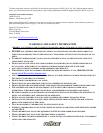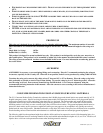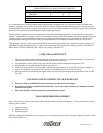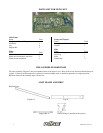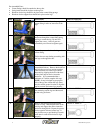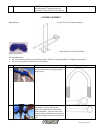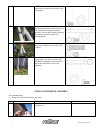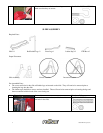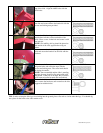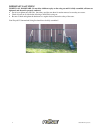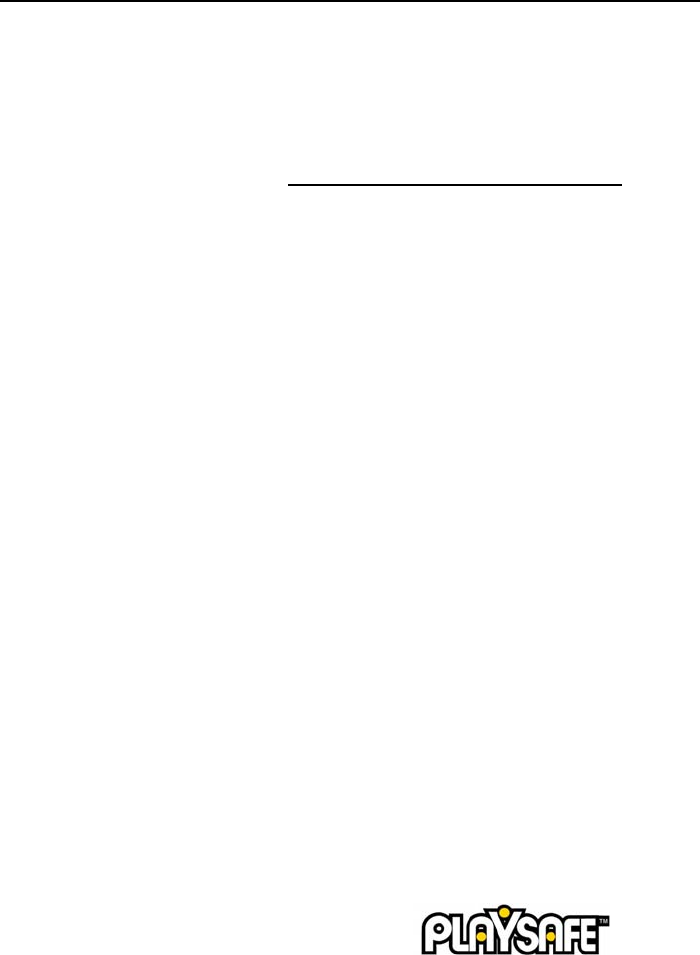
3
©
2006 Pacific Cycle, Inc.
• E
QUIPMENT MAY BE SLIPPERY WHEN WET
.
D
O NOT ALLOW CHILDREN TO USE THE EQUIPMENT WHEN
WET
.
• P
ARENTS SHOULD REGULARLY CHECK OPENINGS AND SURFACES
,
SUCH AS SLIDES
,
FOR ITEMS THAT
MAY BE HAZARDOUS
.
• P
ARENTS SHOULD CHECK SWING
CHAINS
TO INSURE THEY ARE SECURE AND CAN NOT BE LOOPED
BACK ON
T
HEMSELVES
.
• D
O NOT PLACE ANY PART OF THE BODY NEAR MOVING PARTS ON GLIDE RIDES OR TOP BRACKETS
.
• N
EVER SLIDE HEAD FIRST DOWN THE SLIDE
.
• V
ERIFY THAT ALL SWINGS AND CHAINS ARE SECURED AT BOTH ENDS
.
• NEVER
ATTACH ANY MATERIALS THAT ARE NOT SPECIFICALLY DESIGNED FOR USE WITH THIS SWING
SET
,
SUCH AS JUMP ROPES
,
PET LEASHES
,
ROPE OR CORDS AND OTHER CHAINS AS THESE POSE A
POTENTIAL STRANGULATION HAZARD
.
PROPER USE
This swing set is designed for use by children ages 2 to 10 under adult supervision. The maximum number of users this
unit is intended for is 6 children with a maximum weight of 105 lbs each. The maximum fall height for this swing set is
74”.
Single Ride (i.e. Swing) 105 lbs
Double Ride (i.e. Glider) 210 lbs
This product is designed for normal residential use only. This product is not designed for use in day care, nurseries, or
other public places. This product is to be assembled by adults only in the manner described within this owner’s manual.
The swing set must be anchored.
Anchors are not included in this carton. For more information on anchoring, please see
the section below.
ANCHORING
ANCHORING is necessary to prevent tipping, lifting, and overturning. Playsafe™ recommends anchoring the swing set
in concrete, especially in soft or sandy soil. When this is not possible, anchors can be purchased by calling 1-800-242-6110.
To anchor the swing set in concrete, dig a hole at least 5” deep and 10” to 12” in diameter. Place the swing set leg in the
hole, preferably on a brick or stone to keep if from sinking. Be sure the swing leg is set 3” below the ground. Also make
sure the swing set is level. Pour concrete around the legs and fill the hole. Cover concrete adequately using the
recommended surfacing instruction in this manual. Allow the concrete to cure according to the concrete manufacturer’s
instruction before use.
CONSUMER INFORMATION FOR PLAYGROUND SURFACING MATERIALS
The U.S. Consumer Product Safety Commission estimates that 100,000 playground related injuries are treated annually in U.S.
hospital emergency rooms. Injuries involving this hazard pattern tend to be among the most serious of all playground injuries,
and have the potential to be fatal, particularly when the injury is to the head. The surface under and around the playground
equipment can be a major factor in determining the injury-causing potential of a fall. It is self-evident that a fall on a shock-
absorbing surface is less likely to cause a serious injury than a fall onto a hard surface. Playground equipment should never be
placed on a hard surface such as concrete or asphalt and while grass may appear to be acceptable it may quickly turn to hard,
packed earth in areas of high traffic. Shredded bark mulch, wood chips, fine sand or fine gravel are considered to be acceptable
shock absorbing surfaces when installed and maintained at a sufficient depth under and around playground equipment.
The following table lists the maximum height from which a child would not be expected to sustain a life-threatening injury in a
fall onto four different loose-fill surfacing materials if they are installed and maintained at depths of 6, 9, and 12 in. However, all
injuries due to a fall can not be prevented no matter what surfacing materials are used.




